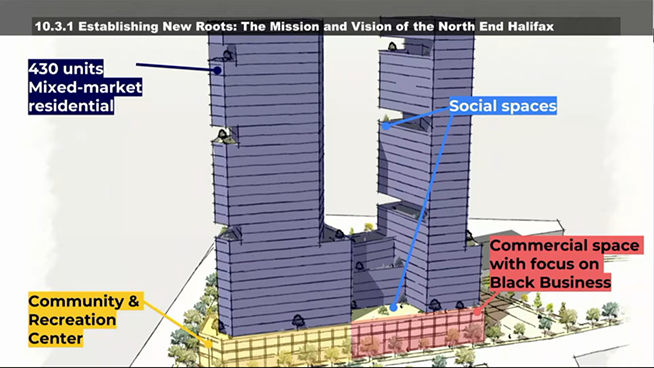This Haligonian is asking the city to right its historic wrongs

Treno Morton grew up in Uniacke Square.
He has witnessed the gentrification and displacement in Halifax’s North End communities. He has heard stories from his elders about the destruction of Africville by the city.
Now, he’s asking the city to divest a section of the Cogswell district so African Nova Scotian roots can be solidly planted in the soil once more.
As the urban engagement and planning specialist for the non-profit Inspiring Communities, and the driving force behind the New Roots Community Land Trust, Morton took the lead in a presentation given to Halifax’s Community Planning and Economic Development (CPED) committee on Thursday, May 16.
Morton made his intentions very clear to the committee: the city has committed many historical wrongs to the African Nova Scotian community in Halifax, and the divestment of a portion of the Cogswell development to the New Roots land trust could help in making things right.
Land trusts have been utilized by marginalized communities since the 1800s to create communities owned by and for the people in them, typically through a non-government organization body (such as New Roots), to avoid displacement and allow for economic and social prosperity.
The idea has only taken off in Nova Scotia over the past five years or so. Despite this, a few land trust projects have commenced, including one led by Dr. Lynn Jones to develop the Down the Marsh trust in one of Truro’s historically Black communities, “The Marsh.”
Morton first heard of the concept from Curtis Whiley, a friend of his who has been doing the same with the Upper Hammonds Plains Community Land Trust.
“He was able to have early success with the rezoning in the area,” said Morton. “So, when developers do come in, they actually have to confer with the community and they really have to adhere to what they say.”
Growing up in Uniacke Square
Vita Cooper
Morton says when he looked around his neighbourhood as a kid, it looked as if he was being forced down a path of sports or entertainment. He chose urban planning.
Morton sensed from a young age, living in Uniacke Square, that African Nova Scotians and their neighbourhoods were being “neglected” by the city.
“I grew up realizing when you go take day trips down to Point Pleasant Park, and go through South End communities, and you see tennis courts, you see swimming pools, and stuff like that,” said Morton. “But in my community, there’s like, four to five basketball courts within a three-minute walk from one another.”
To Morton, designs like this weren’t an accident. “It was comprised this way and continued to be built up this way,” he said.
“That was like, the first sign that like, okay, they [the city] don’t really see much of a future for me, or people that look like me, outside of basketball, sports, or entertainment.”
This inspired Morton to prove the city wrong. He’s currently enrolled in a master’s program for urban planning, and his interest in planning may soon reverberate throughout his community.
Positives and negatives
In Morton’s presentation to council, he voiced the intention to construct a large-scale, mixed-use development with commercial and social spaces, along with mixed-income residential housing with affordable units, all prioritizing the African Nova Scotian community while allowing other communities to thrive.
Morton hopes this will create jobs in the area, as well as a space for improved healthcare access for African Nova Scotians and a community for both elders to enjoy and children to learn from.

Treno Morton
Treno Morton showed off this design for the select parcel of land he’s asking the city to divest New Roots Community Land Trust. It features mixed-residential spaces, commercial space for Black-owned and operated business, as well as social space and a community centre.
The CPED committee responded positively regarding the divestment of a block of Cogswell for the project, passing a motion for planning staff to write a report to council on the proposal.
Morton also felt the presentation went well.
“I was already optimistic going in, but I felt really great, just hearing all the positive feedback,” he said. “They asked questions that we expected and prepared for.”
However, the fight for the trust to come to fruition has only begun, and Morton is already gearing up for their next step: presenting in front of council, where he expects there will be plenty more questions, all varied, and all probing for as much information as possible.
The difficulty for Morton and the trust is that they do not yet own the land, and without it, are unable to go into too much depth with what they plan to do with it. Even their conceptual drawings shown before the CPED committee had been labeled by one member as “putting the cart before the horse.”
It also makes it difficult to get other individuals and organizations completely on board.
“That’s kind of been tying our hands with different grants and things like that,” said Morton. “With their deadlines passing and stuff, because we don’t yet have the land, it’s at this point (an) intended plan, what we intend to do.”
Thankfully, the community’s support is already there.
“I’ve only heard positive things,” said Morton. “I’m assured that there are people who are going to contest this work. Typically I hear that those folks are going to be developers, but residents that I speak to—Black, White, and everything in between—[have] been in support and understand.”
On top of that, they also have the Canada Mortgage and Housing Corporation and Housing Nova Scotia on board with the project, says Morton. It’s now up to city council to decide whether or not they’ll allow the parcel of land to be divested to the New Roots trust.
If you want to contribute to the success of the New Roots Community Land Trust, Morton is planning to start a GoFundMe page where people can pledge financial support.



